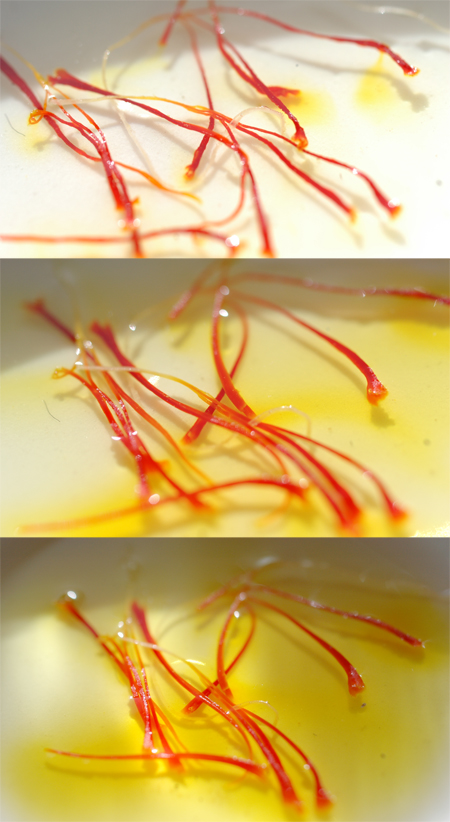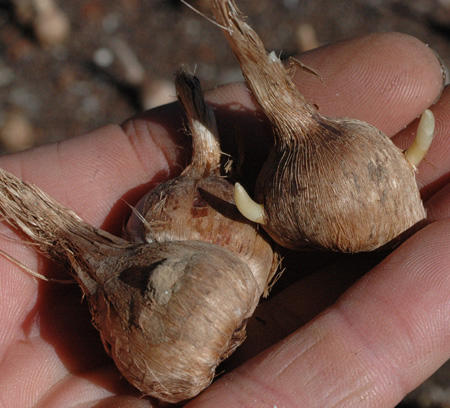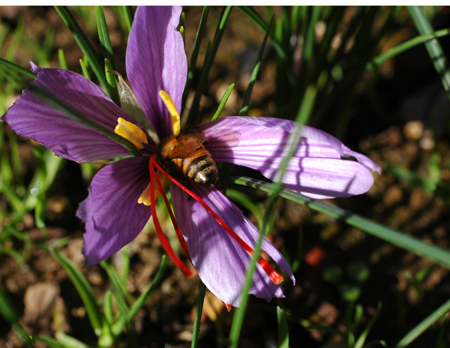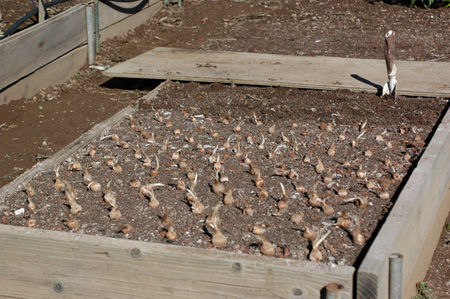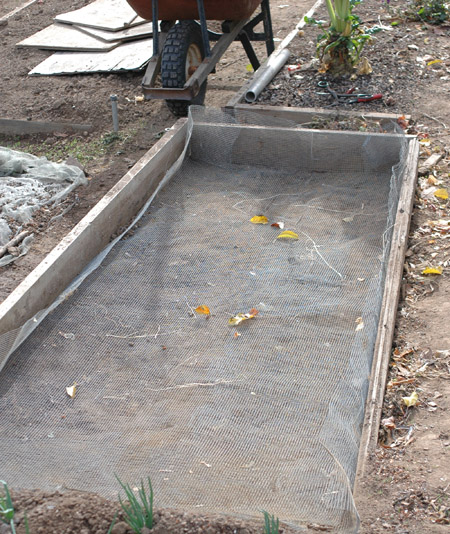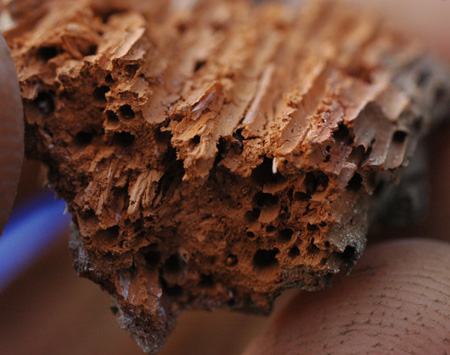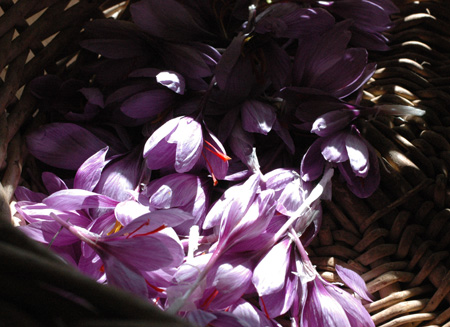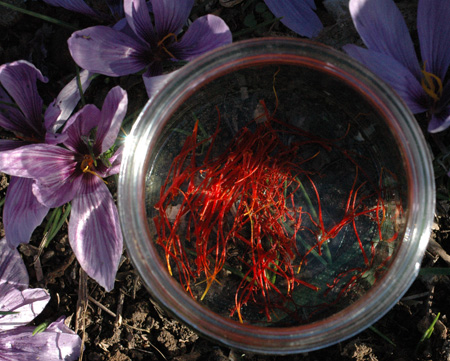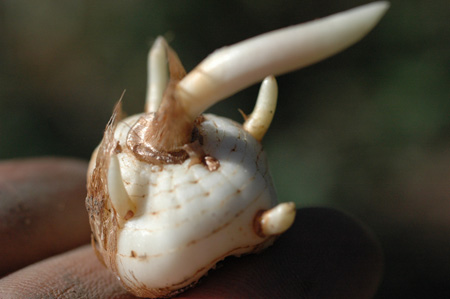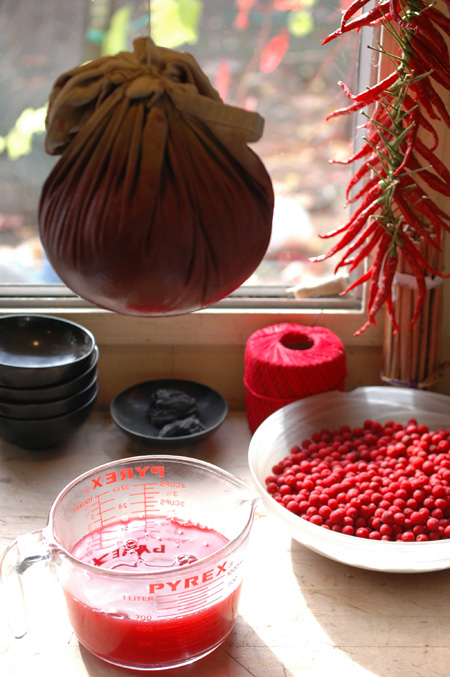I like to cook intuitively with what happens to be on hand, which means having a certain familiarity with my ingredients. Recipes are just guidelines in my world and not to be taken at face value, ever. I’ve never had enough Saffron around to become familiar with it to the point that I can use it with any confidence. When my mom brought me a small box of quality saffron from Spain, I had a chance to become a little more familiar. With Saffron now on my radar, I of course decided I should grow the stuff instead of buying it. I mean if we can grow the stuff here, why import it at 80.00 an ounce? Saffron seems to be capable of growing in a fairly wide variety of climates from England to Afghanistan. Then I could sell the bulbs and promote the idea of growing it and start a local industry and.....
A laptop surfing safari turned up a few small scale growers focused on high quality Saffron for local consumption, but none of them in California. Aside from these geeky boutique producers who have been bitten by the Saffron bug, saffron production seems to be left to areas where it has long been cultivated.
Saffron’s peculiarly unique flavor is subtle and pervasive at the same time. A few threads too many and it goes from enhancing your dish to ruining it. Fortunately, it’s intensity means that only a few threads are required and if it wasn’t so intense, no one would likely be able to afford to use it at all, nor probably bother to. The part used is the intensely red stigma of a pretty little purple/blue flower named Crocus sativus, the stigma being the female part that receives the pollen. The Latin name is probably pronounced like kroak-us sa-tee’-vus, or sat’-i-vus but no one really knows for sure because Latin is a dead language. So just say it however you want to and if anyone flicks you shit for pronouncing it wrong, just follow Jepson’s advice of The Jepson Manual: Higher Plants of California:
"... practice what sounds good to your ear; conviction is important." "When someone presumes to correct your pronunciation, a knowing smile is an appropriate response."
That's always worked for me :D
Anyway, there are only three stigma or “threads” in each flower. Not only are there only three, but they have to be removed by hand one flower at a time. The threads are already small and they dry into teeny weeny little flakey things looking something like pubic hair from a redheaded elf.
Crocus carwrightianus is probably the parent of the Saffron Crocus, and is a normal seed producing plant that exists in wild seed propagated populations. Crocus sativus on the other hand is a mutation or hybrid of some type, and it never produces seed, but can only be grown and propagated by redistribution of the underground parts. So, Saffron Crocus is probably entirely dependent on humans for it’s survival and propagation. Although the stigma of Crocus cartwrightianus can also be used to make saffron, it is almost exclusively made from Crocus sativus. All of the sources I can find indicate that the Saffron crocus has either more or better flavor than C cartwrightianus, and/or that C Sativus produces more Saffron per plant due to heavier Stigmas. Regardless, I'm interested in picking up some cartwrightianus to play with. Cartwrightianus, now there's a clunky name that I can never remember. I guess if I discovered it I could name it Edholmianus. I'm not sure I like it, and it sounds pretty dirty.
*All Crocus species grow from corms. A corm is something like a bulb. Corms and bulbs are similar in appearance and both have evolved primarily as storage for food, water and nutrients when the plant is dormant. A bulb is made up of layers which are actually the bases of leaves; onions are a good example of a bulb. Corms on the other hand evolved from stems and are basically an underground portion of swollen stem. the Structure of the two are very different, a corm contains no layers, just a solid starchy center. Many corms and bulbs rely on reproducing by dividing underground and some grow much more commonly from small bulbs or corms produced underground than they do by seed. The bulblets or cormlets formed around the main one break off or are moved underground by the labors of rodents. Saffron is such a plant and is completely reliant on this vegetative method of reproduction. Since Saffron is sterile. Reproduction by vegetative means only is probably not adequate to keep it afloat in natural environments over the long term, so it would probably be a genetic dead end if we did not keep it alive by cultivation. A Saffron corm produces small cormlets around it’s base each growing season and those mature into large corms before flowering. To Create new plantings, the corms or cormlets are dug up and transplanted. Small corms are easily left behind to grow as they can be very small and difficult to find.*
I started with a few dozen or more saffron corms which I ordered online. I can't remember how many actually. They were around .45¢ apiece when ordering 200 or more, so I split an order with friends and family (EDIT 9/15/14: see comments below for really cheap saffron bulbs!) They reproduced well the first year and I harvested a little saffron in the second growing season. Since reproduction is exponential, It wouldn’t be long before I’m hitting thousands of corms, that is if it weren’t for gophers. I’ve got quite a pile of corms now, but I’ll bet I lost over half to gophers last year, maybe more like two thirds :(. It took a couple years for a gopher to find them, but once one did sniff them out, it set up camp and really went to town.
Saffron farmers grow the plants in cultivated soils. Fertilization is light (if at all) and water is not an issue in most climates and certainly not in mine. As far as I can tell though, the plants are cultivated regularly to reduce competition and occasionally dug and replanted to prevent crowding. Saffron plants are tough and not far removed from the wild state, but there is no reason to doubt that they will, like almost all plants, produce more if they are weeded and cared for. But I don’t want to do that. Intensive cultivation of saffron is just not a priority here. If the plants can survive in dry soils without excessive pampering, that sounds more like what I’m looking for. I like to think of some resources here at Turkeysong as sort of “latent resources”.... stuff that can mostly take care of itself, but can be encouraged, harvested or used when I want or need it. My vision (which may be totally bogus...;) is to establish the plants on uncultivated ground and let them grow unmolested for the most part, except for harvesting of the corms and saffron threads. Though only experience can tell, I suspect that this could work in terms of plant survival in the fairly long term, that is if it weren’t for rodents.
It is alleged that Voles, Gophers, Mice, and Squirrels are all fond of the Corms. We have all of the above, though I think the gophers are going to be the biggest problem, with voles coming in second. I’ve been pondering how to foil the rodents in larger plantings, because it will just be a matter of time until they find the corms. A couple of field planted corms I put out survived, but most have disappeared. Gophers and voles live in cultivated ground as well, but the cultivation can slow them down just a bit by destroying tunnel systems. We certainly have wild bulbs and corms here that survive, but as far as I’m aware, all of them reproduce by both seeds and corms. Brodiaea species are probably the closest to saffron. Brodiaea can produce an abundance of cormlets which are often left in the soil to regrow when an animal or person eats the main corm.
So rodents are the first problem. Another problem is yield. Plants surviving on their own is one thing, but yielding enough to matter is another. I have little doubt that I can grow more flowers with heavier stigmas in a cultivated situation than by just establishing the plants and leaving them to fight it out in the wild. What I don't know is whether naturalized plants will grow enough saffron of high quality to bother harvesting and processing.
So, how to keep the rodents from eating the saffron corms.... hmmmm..... When designing a thing or system from scratch, it’s good to dream big. Laying out a list of ideal parameters sets the bar higher and we’re more likely to end up with what we want. From there, it is generally a matter of compromising more or less of those ideals, which is not necessarily a failure, it’s just a process to do the best we can with what we know. What I envision an ideal Saffron system to be like here would be:
*No maintenance
*Produce income
*Self replicating
*Natural(ish)
*Attractive
*Part of another system (maybe a layer or dimension in another system in space, time, nutrient use etc...)
I have a feeling that if it weren’t for the gophers, I could get close to this ideal by just planting in very large masses. No maintenance would probably fly here, except when digging corms for propagation or thinning, but that isn’t really maintenance if I can sell the corms, it’s income work. I don’t expect it to harvest itself... though it would be nice! And then if such a naturalized system did work, one could add labor here and there, as wanted, to increase yields and profits. Thinning the corms (oops, I typed bulbs instead of corms, if I do that again, slap me.) would likely produce more saffron since old clumps of bulbs and corms generally become crowded and less floriferous over the years. But of course, the full sized corms could be sold, and at around .50¢ apiece, that could be some significant buckaroos just for running around with a shovel for a while. Weeding and maybe fertilizing could be done to boost production, but the cool part would be that you could neglect it at any time and still get some production, and it would just be there hanging out if you wanted to nurture it more at any time in the future. That is what I’m after!
One option that occurred to me is making an engineered soil between 8” and 12” inches deep. the mix would be of oyster shell, probably some charcoal, soil, and gravel of various sizes. The oyster shell would shift the ph into a more comfortable range for Crocus. The concept being that the gravel would prevent rodents from digging their way to the corms, but the roots could still navigate through the spaces between rocks to find their way to the less stony soil below. It seems within the range of possibility that such a system could function well enough, but it also seems within the range of possibility that it could be a complete failure, or simply too costly in time and labor, especially for a large area. What is probably a deal killer, is that having the corms planted in a gravel mix could potentially limit my access to them nearly as well as it limits the rodent’s access. I would approach this idea carefully and do a few years of trials before committing to anything. Even if it is not 100% effective it might really slow them down digging through all that gravel. Making a 3x3 area should be somewhat telling.
Another option I’m thinking on is stainless hardware cloth. Hardware cloth is the galvanized square welded wire mesh that comes in sizes from about 1/8” to 1” inch. This year I had to line my saffron bed with it. I actually moved the saffron corms to another bed, but a gopher found the new bed right away, so I pulled up the already growing plants laid down mesh in the whole bed, and replanted it. No gophers so far. I’d like to shy away from such manufactured materials for sure, but stainless is something of a game changer. Good hot dipped galvanized hardware cloth is pretty tough stuff, but the soil is a rough place for metals. Stainless is nearly inert though and could last for what, centuries maybe? Hella long anyway. It is expensive stuff, but then so is Saffron! With it’s fairly rapid replication at .50¢ a corm it's worth crunching some speculative numbers, and dog knows how much I could sell local saffron in cute little containers for.
There are two options I see with the stainless wire. One is to simply line beds as I did this last fall. The second idea is to enclose a large area with an underground fence. I’d have to do a little more research, but I think about 3 feet deep is beyond the depth a gopher will travel. So, maybe a 3’ foot wide wire, buried 2.5’ feet deep might suffice, leaving a 6” inch “fence” above ground for the occasional adventurous gopher roving above ground. I can think of a few more tweaks to make that more effective too. Using that system, a given amount of wire could enclose a much larger area than if just lining out beds. It’s still a sizable investment. This company has 1/2” mesh at about 950.00 per 100 foot roll 48” wide http://www.twpinc.com/1-2-mesh-047-wire-diameter-t316 Four rolls of that stuff making a 100 x 100 area would be 10,000 square feet of gopher free zone, which is about 1/4 acre. compare that to lining 4 foot beds with the same material and the area covered would be paltry.
At those prices, and simply considering investing so much resource into a project, I would want to be sure that the system worked well and was profitable enough to pay itself back in 5 years or less and then generate income from there on out. One potential problem is that I don’t yet know how much of a problem voles would be. I think they could be quite a problem. They don't do as much burrowing as gophers, but they do dig and burrow and once the figured out that there is food to be had I imagine they'd get pretty good and diggin' those little morsels up. I’m very familiar with voles and 6” inches of “fence” isn’t going to stop them. But, then again, using 4 foot wide wire, 1 or 1.5 feet of above ground fence angled outward just might stop almost all of them. Add a slick material like aluminum printing plates, and that would stop them for sure.
I think this idea could really work, though more likely for intensively cultivated fields with a higher profit. There are some issues, the biggest being cost outlay. You couldn’t just make a small area and then expand like you could with most systems, because digging up fragile mesh wire buried 2 or 3 feet deep would be ridiculous and, practically speaking, impossible. You’d have to have it lined out the size you wanted and then just install it all in one go with a trencher. The cool thing is that the larger you make it, the more cost effective it is. While 400 linear feet will enclose 10,000 square feet, 800 linear feet will enclose 40,000 square feet, which is nearly an acre! Twice the material for 4 times the enclosure is a pretty sweet deal for anyone that is losing significant portions of a valuable crop to rodents. I know some people who bought a vinyard and were literally wiped out by gophers. That makes 5000.00 an acre for permanent gopher exclusion sound less horrible, and 10,00o for 4 acres even less. Probably not gonna happen here, but something to think about.
Finding a way to grow the corms without much care is very appealing. The harvest and processing of Saffron threads is simple enough, but very time consuming. If the stigma could be harvested and dried without having already gone through the extra effort of growing them out under cultivated conditions, the profit margin per effort might go up as long as there are enough flowers per area that harvesting is still pretty efficient... i.e. if you don’t have to walk three feet to reach every flower. That is not a given though as the weight of each stigma may be less under the tougher field conditions than it would be under cultivation. However, I have a strong suspicion that the wild grown Saffron may be somewhat more powerful than that from cultivated flowers; that is the case with many herbs at least.
I hope to be experimenting over the next many years in Saffron growing, with a focus on naturalization of the corms in a low input system.
What I’d like out of a naturalized Saffron system is:
*No, or low, fertilizer or water inputs, No fertilization, or at least very little, like a one time application of something like charcoal (more of an amendment) or a mineral substance.
*Yields high enough to bother harvesting for sale
*Access to the Corms by digging for expansion of plantings or sale to other would be saffron growers (selling corms might very well be as, or more, profitable than the threads).
If the plant behaves like other corm bearing plants in our environment then it seems like naturalization could work with a small amount of human effort at establishment. I’m not talking about a no input system, although that would be nice, just very low input, or input as desired to boost yields. This is sort of a permaculture ideal, with the addition of making it somehow complement other plants and systems. That's all very nice, but bringing such an ideal into fruition when competition is such a huge player in shaping plant communities (at least by my observation in my environment). Competition for water is not likely a problem given that the plants grow in the wet season, but competition for nutrition and light are problems to be reckoned with in a basically hands off system. Speculation and "designing" can't go very far and only getting the plants out there can tell us what reality has in store. I've done the rodent experiment already, and sure enough, they seem to really like those tasty little corms. I've taken the internal part about as far as I care to try and now I just need to get more stuff in the ground.
If you want to grow Saffron, it should be planted in the late summer or early fall. I imagine it’s a bit late now in some places, but can still be pulled off around here no problem. The corms are pretty tough and can probably be dug and replanted at almost any time in most areas with good survival rates. They might not thrive, but they'll probably survive and get their act together the following year. If you buy in larger quantities, it’s a lot cheaper, so pool together a few friends and buy 100 corms or more to split up. They reproduce pretty fast and remember, growth is exponential! So, if they reproduce an average of 4 to 1 in a year and you start with 25 corms, the math is 25, 100, 400, 1600, 6400, and 25,600 in just 5 years. You get the idea. Be aware also, that investing in more bulbs won't save you proportionally more time. Paying 4 times as much for 100 bulbs will only save you one year, kind of the opposite of fencing in larger areas with proportionally less fencing. Patience pays here. Be mindful though that most of those are small corms that won’t flower for at least another year, but in terms of planting stock for a permanent planting, they are fine. Ideally, one would buy smaller corms for field planting at a lower rate, but I've yet to find anyone selling small sized bulbs at all. Saffron Crocus may very well reproduce faster, I’m not sure how many offshoots they produce a year. I’ve been growing them in a garden bed to multiply them as fast as possible. If not for the gopher attack, I might have 3000 to 4000 corms by now.
All this speculation makes me hungry. I think I’ll have a piece of home baked chiabatta toast with some of my blood apple, saffron jelly. Mmmmm.... I’ll be you want some... mmm.... it’s sooooo goooooooood.....
There are a bunch of cool you tube videos on saffron cultivation and harvesting that are worth checking out just as plant porn if for no other reason. Actually, there are a whole lot of them. Here are some in no particular order.
https://www.youtube.com/watch?v=AR7qS2aVo58
https://www.youtube.com/watch?v=-ziANU5T4Rg
https://www.youtube.com/watch?v=KEQQr-t2ZTw
https://www.youtube.com/watch?v=Ia3PUtzZYNk


